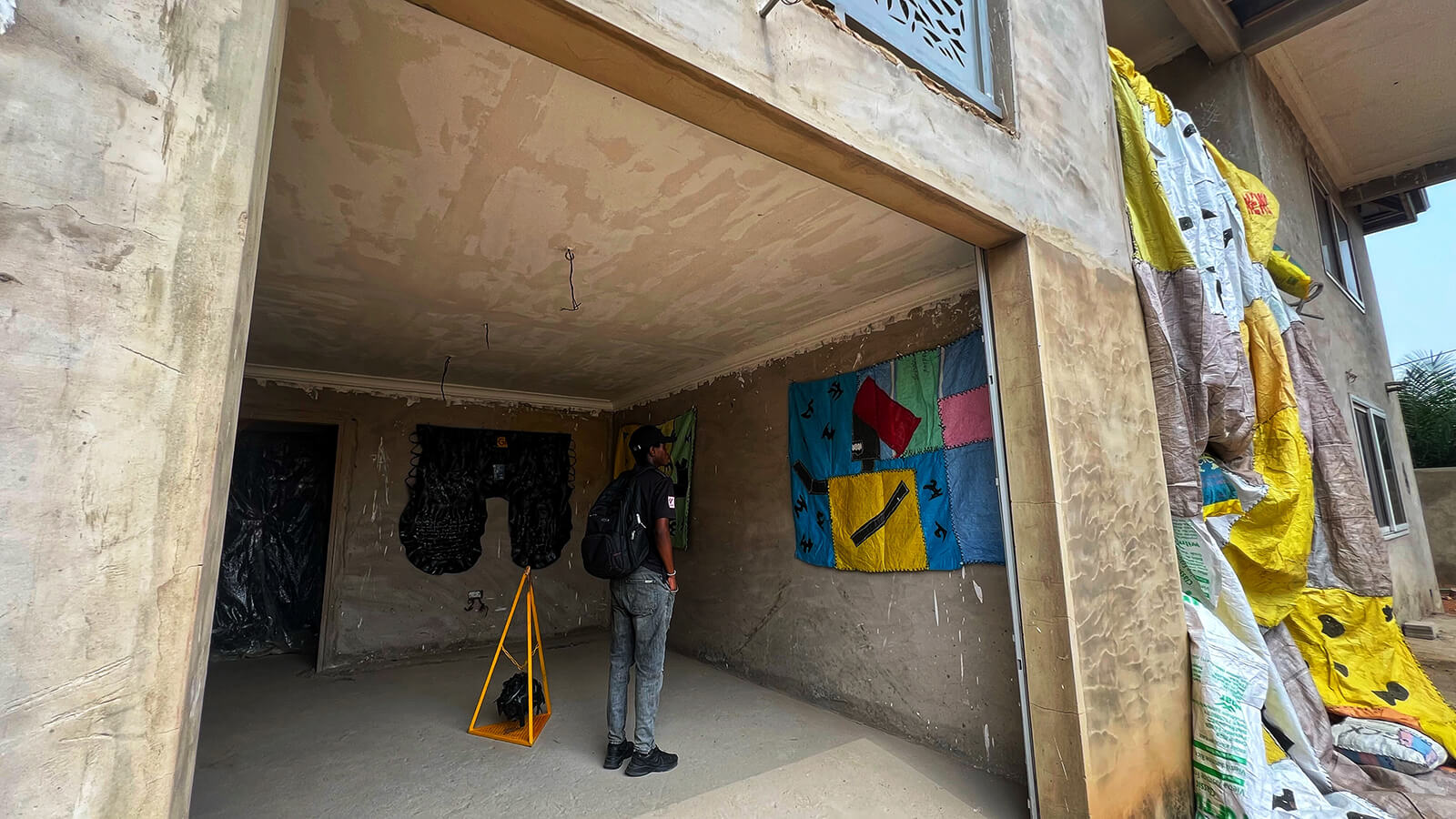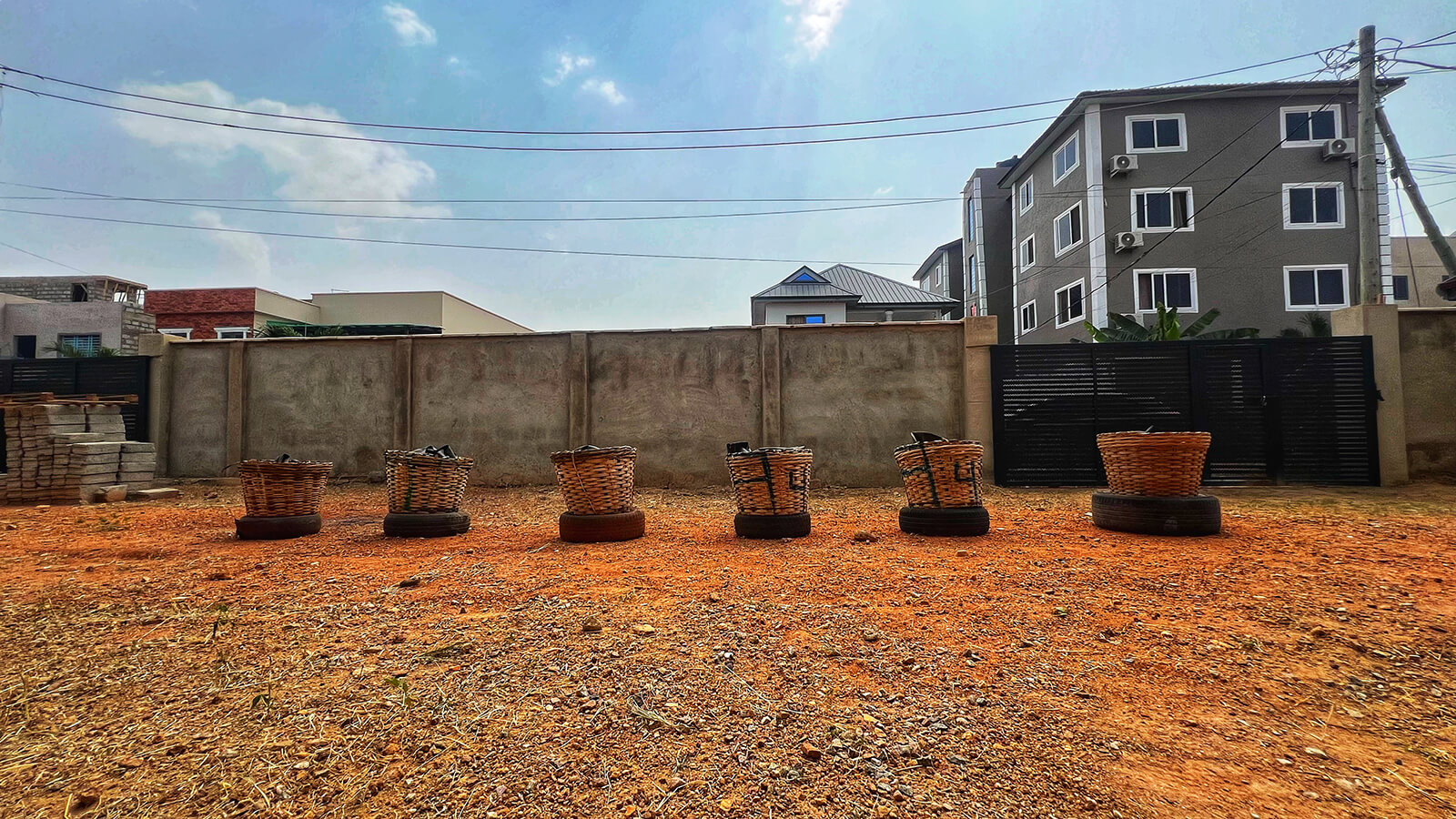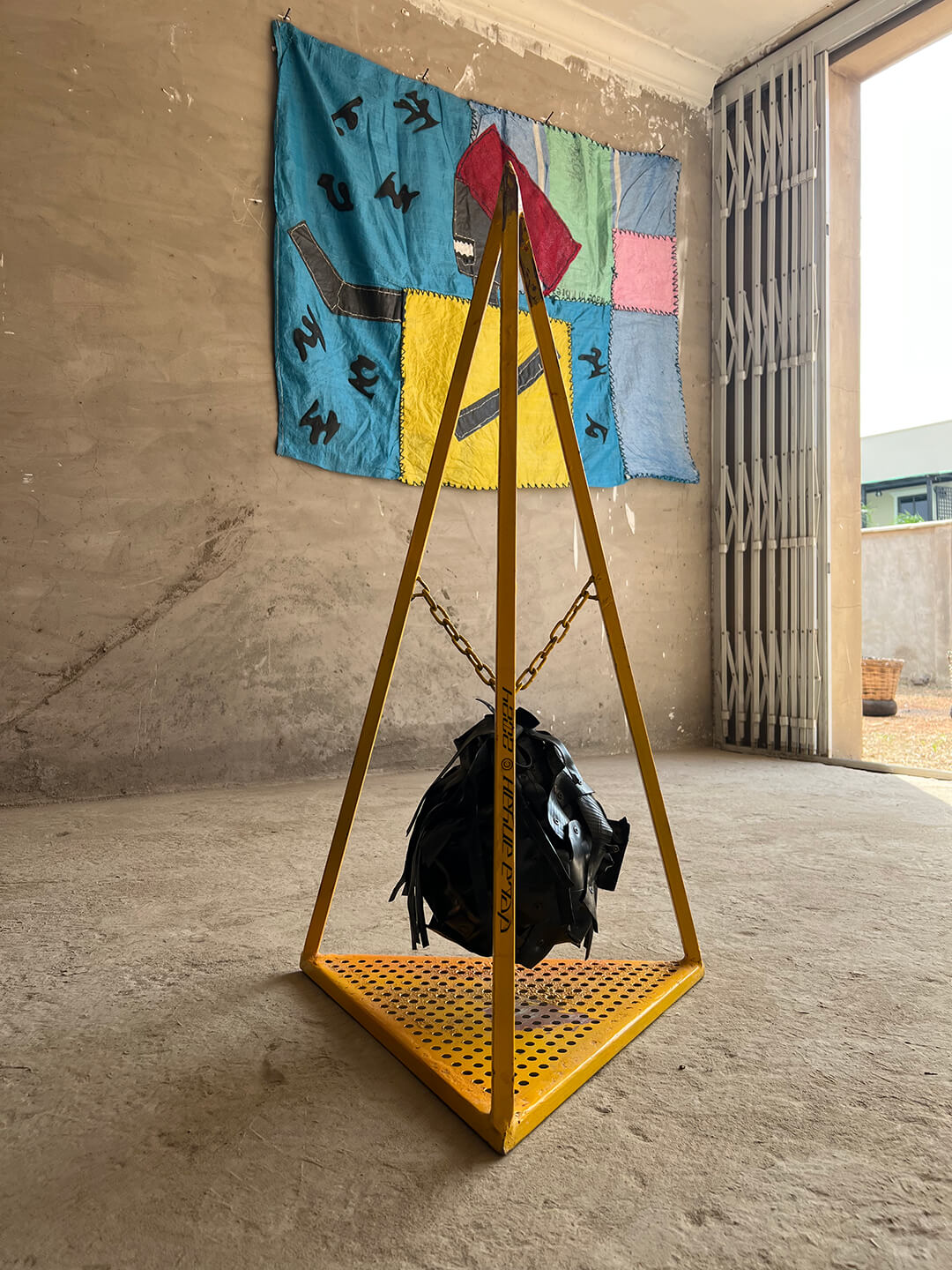Debjani Banerjee navigates myth and identity in 'Jalsaghar' at CCA Glasgow
by Shalmali ShettyNov 25, 2024
•make your fridays matter with a well-read weekend
by Kwame AidooPublished on : Jan 13, 2025
In Beyond Rubber, Ghanaian artist Dela Anyah pushes the expressive potential in inanimate objects by assembling tapestries of interwoven repurposed inner tyre tubes, car number plates, discarded bicycle components and scrapped sacks. The exhibition articulates the visual and textural characteristics of these abandoned elements from Ghana’s automotive industry and market storage points.
With sculpture and installation techniques, Anyah creates abstract compositions to explore global complexities of circulation and value: production to distribution, extraction and consumption to waste. The site, Afrobutylism Studio in Ogbojo, a suburb of Ghana’s capital, is populated with his work in ways that offer new perspectives on imperfection and impermanence. Dark, malleable configurations of meandering inner tyre tubes textured in basketweave style, are seen contrasting with vibrant polypropylene sack tapestries. The raw concrete architecture adds to the vernacular ambience, as riveted car number plates are exposed like accessories. This show adds to the artist’s portfolio of examining material conditions in his immediate environs to creatively capture, analyse and narrate identity.

The studio setting has been illuminating for Anyah. “It creates a chance for me to actually have dialogues with different people. You can have a sit down, to talk about the work, about the practice and the ideas beyond what people just see. There's so much that I've learned personally. It's very immersive,” Anyah explains. The exhibition allows enduring dialogues that come with open studio contexts and maximises the feedback pool that gallery conditions might not easily render. STIR spoke further with Anyah about his practice:
Kwame Aidoo: What inspired you to organise Beyond Rubber and what sparked your interest in transforming discarded objects into artworks?
Dela Anyah: When I moved to this new space I'm working in, I was thinking of how to interact with it and have an intervention that would engage the architecture. It's usually just the typical gallery shows. I feel like I'm moving to this new conceptual realm, where I want to explore conversations about the underlying ideas behind the works.
Back in 2015, when I began painting I was studying Picasso’s techniques and therefore made this painting inspired by him. A collector noticed the resemblance and I didn't take that feedback as a compliment. What I decided to do was research the European artist to find out what inspired him. Realising that Picasso was influenced by African art was that moment of epiphany. The fact that I'm upcycling discarded materials in Ghana opens a path to understanding my contemporary African identity. The language that my work defines has to do with the strong focus on the material.
Kwame: With reference to the material, what are some of the conversations that ensue when you visit vulcaniser, vehicle repair and mechanic spaces?
Dela: Typically, I ask for the costs. Then they respond by asking how much I want to pay. They sometimes go further to inquire what I am going to use the tubes for before responding with answers regarding their instantly-thought-up price. There are times when I visit several shops on the same street and receive varying quotes. Usually, I encounter quick transactional engagements. On rare occasions, when they seem lost or are hesitant about selling, it ends up in a longer discussion since the discarded tubes have no fixed value.

Kwame: In terms of form, we see Beyond Rubber focus on sculptures, tapestries and installations. Why this direction?
Dela: Initially, I was experimenting with how to first understand the butyl material and how to first create what is understood as art with the medium. 2021 was when I bought my first inner tubes and 2022 was when I started getting them into galleries. I feel like sometimes the material needs to do the speaking as the installations tell the story. I am interested in the layers and movement of the materials in communities- like the polypropylene sacks which can be traced to charcoal and rice traders in Accra’s markets. Aside from exploring traditions in basketry, the work goes to engage environmental issues, value and labour. I am thinking about how objects can now come back into society and have a new worth and a new use.
Kwame: When you look back, how have your beginnings–when young and endowed with a dream, helped to navigate the world around you towards this current stream of work?
Dela: I remember an uncle teaching me how to use Microsoft Paint and my mother’s influence as a fashion designer. I filled up the empty spaces in her fashion magazines (those with cardboard-like covers) with sketches. In 2015, I started painting officially. Though I studied in a business and marketing school and did some writing and graphic design along the line, I have mostly been repurposing found items. El Anatsui has been a big inspiration.

Kwame: How has Accra as a dynamic city, together with the constant state of global consumerism, waste and environmental impacts like climate change contributed to your interests
Dela: Accra is fantastic and my favourite district is Jamestown. I go there and look at the colonial streets and the rustic aura of the walls. It feels ancient and it seems like things are time-travelling simultaneously. I pick inspiration from Accra’s spaces and put it in my work. Sometimes in the city, you see a pile of tyres and it’s like a signboard that lets you know there’s a vulcaniser shop at that point. The pile is waste, but in that functional form as a signage, it escapes the bracket of pollution.
Kwame: The exhibition space for Beyond Rubber seems unconventional but intentional. How does that help to get the narrative out?
Dela: How do we define a completed building? I am embracing the idea that this space is complete in a sense – complete to fulfil its role as a space for exhibiting works. The architecture allowed the industrial feel of the works to blend in, from the raw concrete surfaces to the pipes with wires protruding in certain spaces. The idea of the building going through a transformation, just as the materials go from a low value to an increase in value, is part of the dialogue I wanted to create between the works and the building.
Kwame: How does your work engage personal and community identity, histories and culture with reference to your background as an Ewe?
Dela: I was going through a low phase in my life when these layers came to me. The works remind me of stories I heard while growing up. I give Ewe names to some of my pieces. Our culture of naming children is based on the conditions surrounding their birth. As such, my works are given an identity based on circumstances in connection to their creation. I named one of my pieces Akpe, which stands for gratitude.
These objects can be likened to humans. Hope is a gift that continuously nurtures that part of my career. What has been discarded can be brought back to life.
'Beyond Rubber' is on view at Afrobutylism Studio in Accra until Feb 16, 2025.
by Maanav Jalan Oct 14, 2025
Nigerian modernism, a ‘suitcase project’ of Asian diasporic art and a Colomboscope exhibition give international context to the city’s biggest art week.
by Shaunak Mahbubani Oct 13, 2025
Collective practices and live acts shine in across, with, nearby convened by Ravi Agarwal, Adania Shibli and Bergen School of Architecture.
by Srishti Ojha Oct 10, 2025
Directed by Shashanka ‘Bob’ Chaturvedi with creative direction by Swati Bhattacharya, the short film models intergenerational conversations on sexuality, contraception and consent.
by Asian Paints Oct 08, 2025
Forty Kolkata taxis became travelling archives as Asian Paints celebrates four decades of Sharad Shamman through colour, craft and cultural memory.
 surprise me!
surprise me!
make your fridays matter
SUBSCRIBEEnter your details to sign in
Don’t have an account?
Sign upOr you can sign in with
a single account for all
STIR platforms
All your bookmarks will be available across all your devices.
Stay STIRred
Already have an account?
Sign inOr you can sign up with
Tap on things that interests you.
Select the Conversation Category you would like to watch
Please enter your details and click submit.
Enter the 6-digit code sent at
Verification link sent to check your inbox or spam folder to complete sign up process



by Kwame Aidoo | Published on : Jan 13, 2025
What do you think?